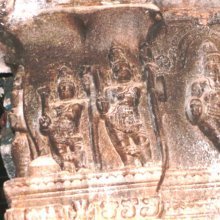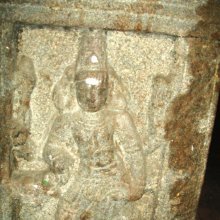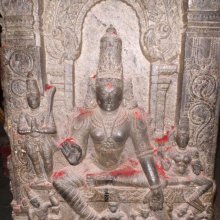Varadahasta, Varada-hasta: 8 definitions
Introduction:
Varadahasta means something in Hinduism, Sanskrit, Marathi. If you want to know the exact meaning, history, etymology or English translation of this term then check out the descriptions on this page. Add your comment or reference to a book if you want to contribute to this summary article.
Images (photo gallery)
In Hinduism
Shilpashastra (iconography)
Source: Google Books: Elements of Hindu iconographyThe Varadahasta (वरदहस्त) shows the pose of the hand while conferring a boon. In this pose the palm of the left hand, with the fingers pointing downwards is exposed to the observer, either as fully opened and emptty or as lightly carrying a small bolus.
Source: Shodhganga: The significance of the mūla-beras (śilpa)Varadahasta (वरदहस्त) or simply Varada refers to “benevolence” and represents one of the twenty-four gestures with a single hand, as defined according to texts dealing with śilpa (arts and crafs), known as śilpaśāstras.—Accordingly, pratimā-lakṣaṇa (body postures of the icons) is comprised of hand gestures (hasta, mudrā or kai-amaiti), stances/poses (āsanas) and inflexions of the body (bhaṅgas). There are thirty-two types of hands [viz., varadahasta] classified into two major groups known as tolirkai (functional and expressive gestures) and elirkai (graceful posture of the hand).
(Description of Varada-hasta): When the abhaya-hasta is held upside down with the palm facing outward, it is known as varada-hasta.

Shilpashastra (शिल्पशास्त्र, śilpaśāstra) represents the ancient Indian science (shastra) of creative arts (shilpa) such as sculpture, iconography and painting. Closely related to Vastushastra (architecture), they often share the same literature.
Shaktism (Shakta philosophy)
Source: Google Books: ManthanabhairavatantramVaradahasta (वरदहस्त) refers to the “gestures of boon bestowal”, according to the Manthānabhairavatantra, a vast sprawling work that belongs to a corpus of Tantric texts concerned with the worship of the goddess Kubjikā.—Accordingly, “(Kāmahā) the Maṅgalā from Kāmarūpa has four faces and is very powerful. She has two arms and sits on a ghost. She makes gestures of fearlessness and boon bestowal [i.e., varadahasta]; she is well adorned with all the ornaments and has a large, pleasing and auspicious face”.

Shakta (शाक्त, śākta) or Shaktism (śāktism) represents a tradition of Hinduism where the Goddess (Devi) is revered and worshipped. Shakta literature includes a range of scriptures, including various Agamas and Tantras, although its roots may be traced back to the Vedas.
Shaivism (Shaiva philosophy)
Source: SOAS University of London: Protective Rites in the Netra TantraVaradahasta (वरदहस्त) refers to “one showing the wish-granting mudrā” and is used to describe Tumburu, according to the Netratantra of Kṣemarāja: a Śaiva text from the 9th century in which Śiva (Bhairava) teaches Pārvatī topics such as metaphysics, cosmology, and soteriology.—Accordingly, [verse 11.1-24ab, while describing the appearance and worship of Tumburu]—“[...] [He worships] Deva as Tumburu in the middle of an eight petaled lotus, in the maṇḍala, [starting] in the East, O Devī. [...] Adorning Deva is a white flower and a spade. [He] holds an elephant hook and noose. Deva [has] a thread with a cakra at the access, hand [held in the] wish-granting and protective [mudrās] (varadahasta—varadābhayahastaṃ). [...]”.

Shaiva (शैव, śaiva) or Shaivism (śaivism) represents a tradition of Hinduism worshiping Shiva as the supreme being. Closely related to Shaktism, Shaiva literature includes a range of scriptures, including Tantras, while the root of this tradition may be traced back to the ancient Vedas.
Languages of India and abroad
Marathi-English dictionary
Source: DDSA: The Molesworth Marathi and English Dictionaryvaradahasta (वरदहस्त).—m (S) The bountiful or beneficent hand (of the Deity &c.) 2 Applied to a teacher who gets his scholars on; to one who confers prosperousness upon all dependent upon or connected with him; to one whose imposed hand confers blessing.
Source: DDSA: The Aryabhusan school dictionary, Marathi-Englishvaradahasta (वरदहस्त).—m The bountiful hand.
Marathi is an Indo-European language having over 70 million native speakers people in (predominantly) Maharashtra India. Marathi, like many other Indo-Aryan languages, evolved from early forms of Prakrit, which itself is a subset of Sanskrit, one of the most ancient languages of the world.
Sanskrit dictionary
Source: Cologne Digital Sanskrit Dictionaries: Monier-Williams Sanskrit-English DictionaryVaradahasta (वरदहस्त):—[=vara-da-hasta] [from vara-da > vara] m. the beneficent hand (of a deity or benefactor of any kind), [Monier-Williams’ Sanskrit-English Dictionary]
Sanskrit, also spelled संस्कृतम् (saṃskṛtam), is an ancient language of India commonly seen as the grandmother of the Indo-European language family (even English!). Closely allied with Prakrit and Pali, Sanskrit is more exhaustive in both grammar and terms and has the most extensive collection of literature in the world, greatly surpassing its sister-languages Greek and Latin.
Kannada-English dictionary
Source: Alar: Kannada-English corpusVaradahasta (ವರದಹಸ್ತ):—[noun] a particular mode of holding one’s hand (said of a deity) that assures favour, boon, grace, safety, etc.
Kannada is a Dravidian language (as opposed to the Indo-European language family) mainly spoken in the southwestern region of India.
See also (Relevant definitions)
Partial matches: Hasta, Varada.
Full-text (+13): Varada, Danahasta, Someshvara, Shanishvar, Dhanvantari, Mangalambikai, Candikeshvar, Solaimalai Naciyar, Urdhvatandava, Arunacaleshvar, Durga, Shiva, Shanishvara, Mayuranatha, Arana Valli, Shrinivasa, Dandayutapani, Balasubrahmaṇya, Kalyanasundara, Goumari.
Relevant text
Search found 3 books and stories containing Varadahasta, Varada-hasta; (plurals include: Varadahastas, hastas). You can also click to the full overview containing English textual excerpts. Below are direct links for the most relevant articles:
Brihat Samhita (by N. Chidambaram Iyer)
Maha Prajnaparamita Sastra (by Gelongma Karma Migme Chödrön)
Appendix 4 - The brahmanical trimūrti (Śiva, Viṣṇu and Brahmā) < [Chapter IV - Explanation of the Word Bhagavat]
Jnaneshwari (Bhavartha Dipika) (by Ramchandra Keshav Bhagwat)
Commentary introduction to Chapter 1 < [Chapter 1 - Arjuna’s Dolour]



